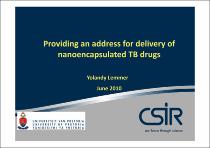JavaScript is disabled for your browser. Some features of this site may not work without it.
- ResearchSpace
- →
- Research Publications/Outputs
- →
- Conference Publications
- →
- View Item
| dc.contributor.author |
Lemmer, Yolandy

|
|
| dc.date.accessioned | 2010-12-06T09:38:14Z | |
| dc.date.available | 2010-12-06T09:38:14Z | |
| dc.date.issued | 2010-06 | |
| dc.identifier.citation | Lemmer, Y. 2010. Providing an address for delivery of nanoencapsulated TB drugs. 2nd South African TB Conference, ICC, Durban, South Africa, 31 May-04 June 2010, pp 16 | en |
| dc.identifier.uri | http://hdl.handle.net/10204/4594 | |
| dc.description | 2nd South African TB Conference, ICC, Durban, South Africa, 31 May-04 June 2010 | en |
| dc.description.abstract | South Africa currently has the highest incidence of TB per 100 000 people in the world. In 2007 alone 112 000 people died of TB in South Africa, of which 94 000 were co-infected with HIV (1). Although TB treatments exist, poor patient treatment compliance and drug resistance pose a great challenge to TB treatment programs worldwide. To improve the current inadequate therapeutic management of TB, a polymeric anti-TB nanodrug delivery system, for anti-TB drugs, was developed that could enable entry, targeting, sustained release for longer periods and uptake of the antibiotics in the cells, hence reducing the dose frequency and simultaneously improve patient compliance. The aim of this study was to prepare functionalised polymeric nano drug delivery vehicles to target TB infected macrophage cells. Successful nano encapsulation of anti-TB drugs and a targeting agent (MA) was achieved. Mycolic acid (MA) may target cholesterol at the site of infection. The nanoparticles were characterized and subjected to in vitro analyses in order to determine their uptake, localization and cytotoxicity in different cell lines. In another approach targeting will be achieved via attaching nucleic acid aptamers specific for the mannose receptor (MR), which is significantly over-expressed during the activation of the macrophages in the presence of M tb onto the surface of drug-carrying PLGA nanoparticles. In conclusion, the aptamer to MR and MA to cholesterol as targeting mechanisms for nanodrug delivery systems will be discussed. Its success addresses the challenges of poor bioavailability, reduced efficacy and adverse side effects for diseases such as TB, HIV and malaria. | en |
| dc.language.iso | en | en |
| dc.relation.ispartofseries | Conference Presentation | en |
| dc.subject | Tuberculosis | en |
| dc.subject | TB | en |
| dc.subject | TB treatment | en |
| dc.subject | Mycolic acid | en |
| dc.subject | Macrophage cells | en |
| dc.subject | Aptamers | en |
| dc.title | Providing an address for delivery of nanoencapsulated TB drugs | en |
| dc.type | Conference Presentation | en |
| dc.identifier.apacitation | Lemmer, Y. (2010). Providing an address for delivery of nanoencapsulated TB drugs. http://hdl.handle.net/10204/4594 | en_ZA |
| dc.identifier.chicagocitation | Lemmer, Yolandy. "Providing an address for delivery of nanoencapsulated TB drugs." (2010): http://hdl.handle.net/10204/4594 | en_ZA |
| dc.identifier.vancouvercitation | Lemmer Y, Providing an address for delivery of nanoencapsulated TB drugs; 2010. http://hdl.handle.net/10204/4594 . | en_ZA |
| dc.identifier.ris | TY - Conference Presentation AU - Lemmer, Yolandy AB - South Africa currently has the highest incidence of TB per 100 000 people in the world. In 2007 alone 112 000 people died of TB in South Africa, of which 94 000 were co-infected with HIV (1). Although TB treatments exist, poor patient treatment compliance and drug resistance pose a great challenge to TB treatment programs worldwide. To improve the current inadequate therapeutic management of TB, a polymeric anti-TB nanodrug delivery system, for anti-TB drugs, was developed that could enable entry, targeting, sustained release for longer periods and uptake of the antibiotics in the cells, hence reducing the dose frequency and simultaneously improve patient compliance. The aim of this study was to prepare functionalised polymeric nano drug delivery vehicles to target TB infected macrophage cells. Successful nano encapsulation of anti-TB drugs and a targeting agent (MA) was achieved. Mycolic acid (MA) may target cholesterol at the site of infection. The nanoparticles were characterized and subjected to in vitro analyses in order to determine their uptake, localization and cytotoxicity in different cell lines. In another approach targeting will be achieved via attaching nucleic acid aptamers specific for the mannose receptor (MR), which is significantly over-expressed during the activation of the macrophages in the presence of M tb onto the surface of drug-carrying PLGA nanoparticles. In conclusion, the aptamer to MR and MA to cholesterol as targeting mechanisms for nanodrug delivery systems will be discussed. Its success addresses the challenges of poor bioavailability, reduced efficacy and adverse side effects for diseases such as TB, HIV and malaria. DA - 2010-06 DB - ResearchSpace DP - CSIR KW - Tuberculosis KW - TB KW - TB treatment KW - Mycolic acid KW - Macrophage cells KW - Aptamers LK - https://researchspace.csir.co.za PY - 2010 T1 - Providing an address for delivery of nanoencapsulated TB drugs TI - Providing an address for delivery of nanoencapsulated TB drugs UR - http://hdl.handle.net/10204/4594 ER - | en_ZA |






